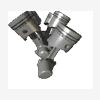Automatics On The Dyno
Announcements
-
Similar Content
-
Latest Posts
-
Should shit that in as for the driver ability probably not
-
Trying to find the plastic under cover for an 04' Forester X. The main under cover that covers most of the front of the vehicle under the engine. This has turned out to be a crazy experience. Normally I can find parts for vehicles, if I have the correct info, no problem. But not this! The Forester is a non-turbo btw. In a Forester parts catalog, for model years 03'-06', it shows part# 56410SA070 as being the correct part. So I go to the local Subaru dealership's website to order it. I type in the part#, hit search and there it is, the under cover. "DOES THIS PART FIT YOUR VEHICLE?" I type in my VIN# and sure enough, "This Part Does Not Fit Your Vehicle. See Similar Parts For Your Vehicle." I click on that and part# 56410SA000 comes up. Looks absolutely nothing like the previous part. Not even close. So I go to a different Subaru dealer website and put in that 2nd part# (56410SA000) and "This Part Has Been Replaced By" 56410SA070, which is the first part I looked up. I thought OK, makes sense. They replaced the strange looking part, with the one I looked up first, so I add it to the cart. "Does This Part Fit Your Vehicle?" I type in my VIN#, and sure enough, "This Part Does Not Fit Your Vehicle." I've basically been doing this with various parts suppliers and dealerships, for the past 4 hours! Does anyone know what the hell is going on?? Thanks in advance!
-
By Looney_Head · Posted
have you rotated the car yet? if so how smooth was it? -
And finally, I had the driver's side airbox off while adding a long drain hose under the oil can to down near the oil filter. Doesn't look good, it has definitely had an turbo oil seal leak and looks like it has been for a long time.....guess I'll have to get a pair of highflows to put on the shelf It's also worth mentioning it has a really strange clamp between the bottom of the airflow meter (which has a big barb/lip on it) and the intake pipe. I've used the magic of MSPaint to show, basically you have to clip out those 2 steel springs which unlocks the hose from the AFM. I used 2 flat screwdrivers, the spring sort of clips into the unlocked position. Reassembly you just pop them both back flat once the hose is far enough up the AFM that the spring clamp is above the barb. Weird to use but much more convenient once your'e used to it compared to trying to do up a hose clamp under the airbox like on 32 GTR
-
The other thing I started was a fire extinguisher bracket. As with a few other cars previously (350z, Leaf), I'm going to add a bracket between the navigator seat's front bolts, then mount the extinguisher on that. Unfortunately Nissan (probably the same engineer who did the A/T fluid interwarmer) decided that the front seat brackets would be recessed and uneven so the bracket shape was a bit tricky; I ended up doing 1 part under each seat mount (the large hole is because there is a flange under the seat mount to allow for the carpet thickness) and then a horizontal part between those 2 No final pic yet as the paint needs to dry, I'll post up once that's done
-







Recommended Posts
Create an account or sign in to comment
You need to be a member in order to leave a comment
Create an account
Sign up for a new account in our community. It's easy!
Register a new accountSign in
Already have an account? Sign in here.
Sign In Now